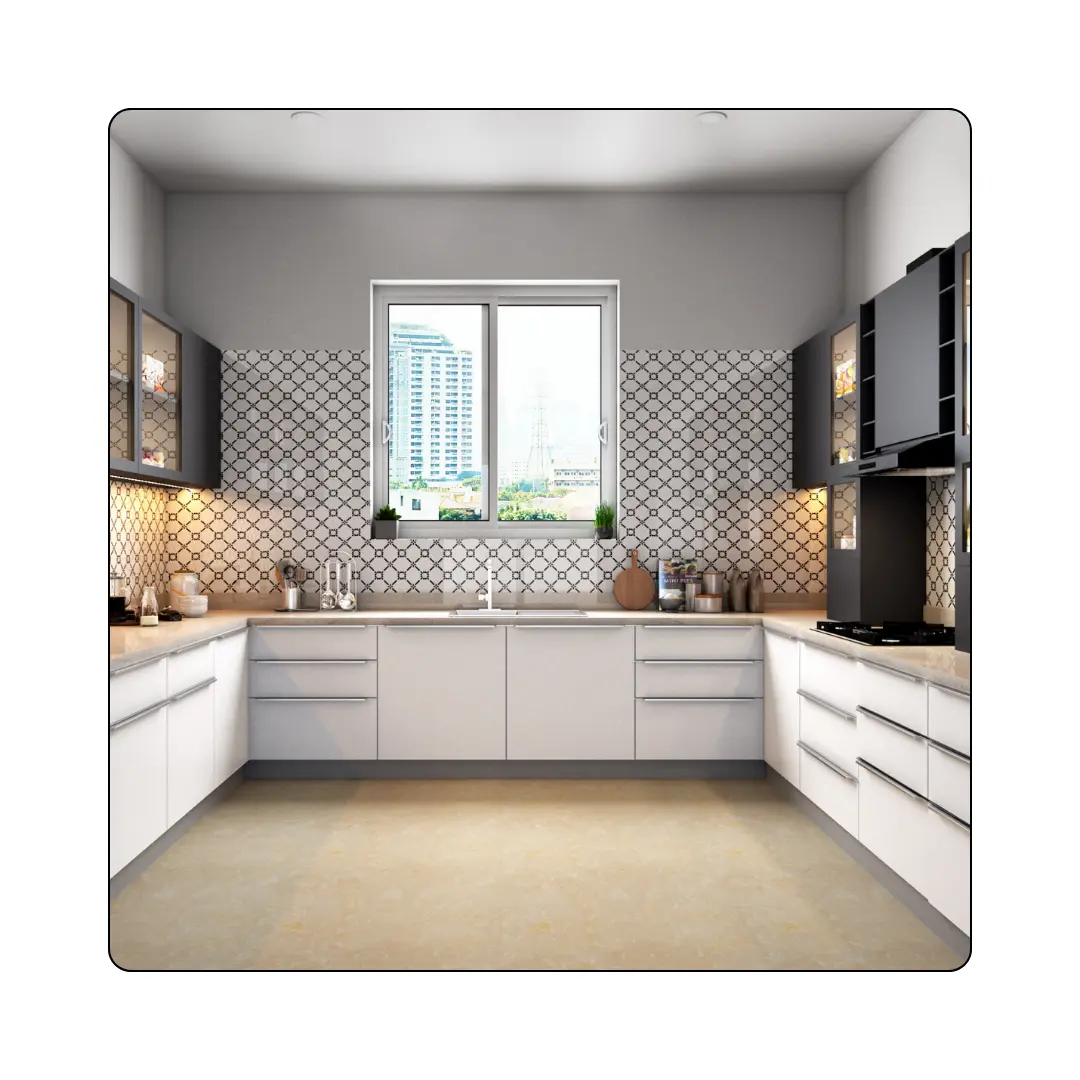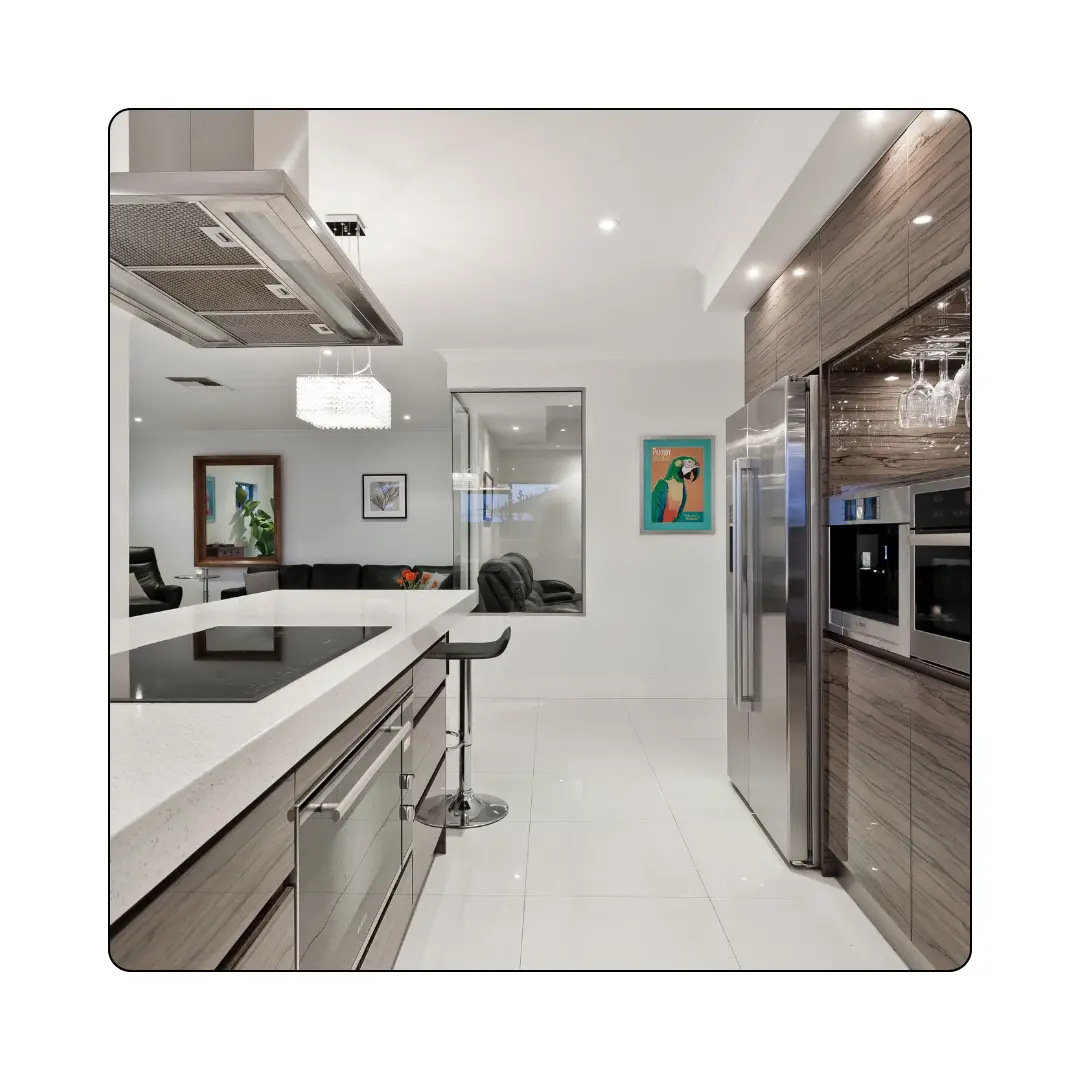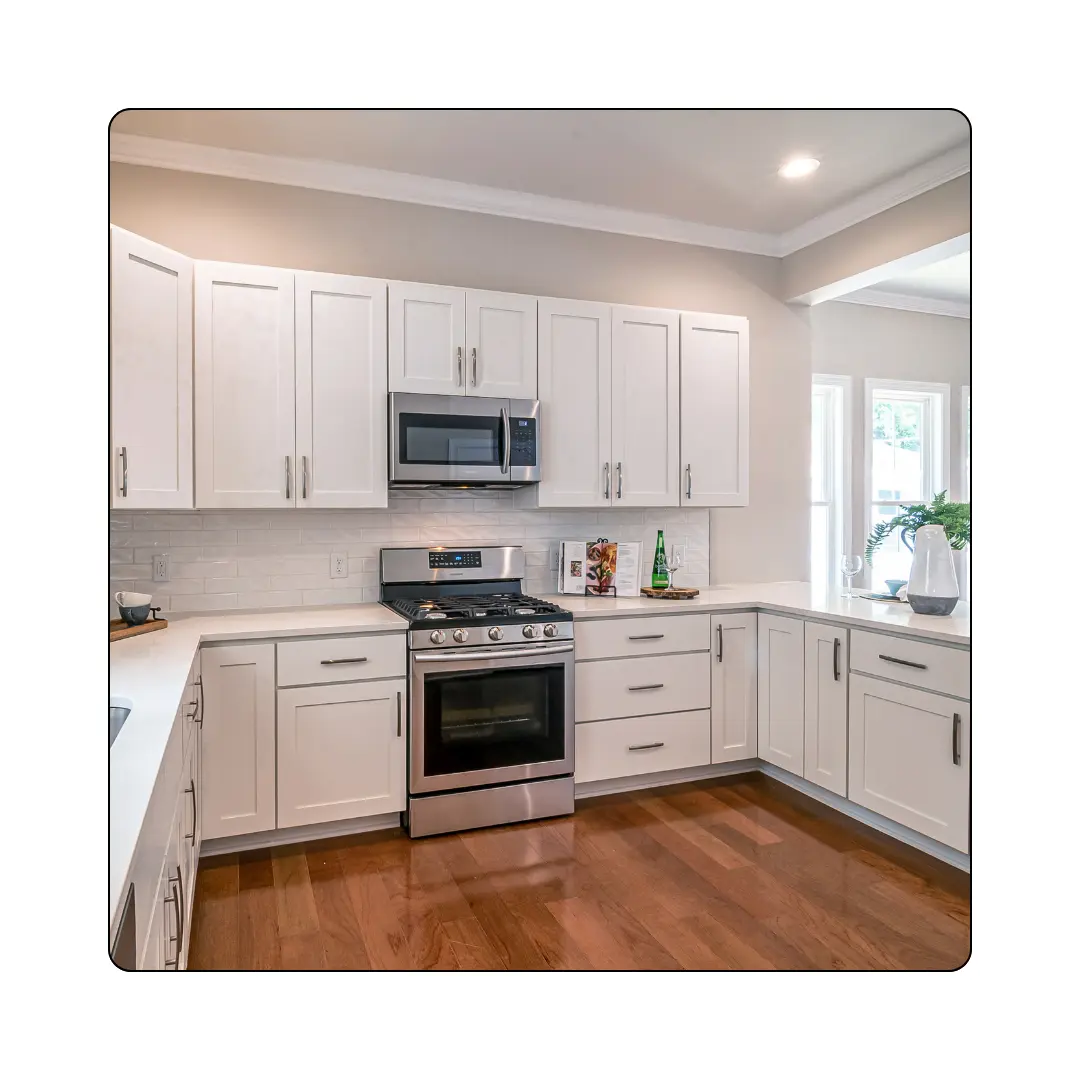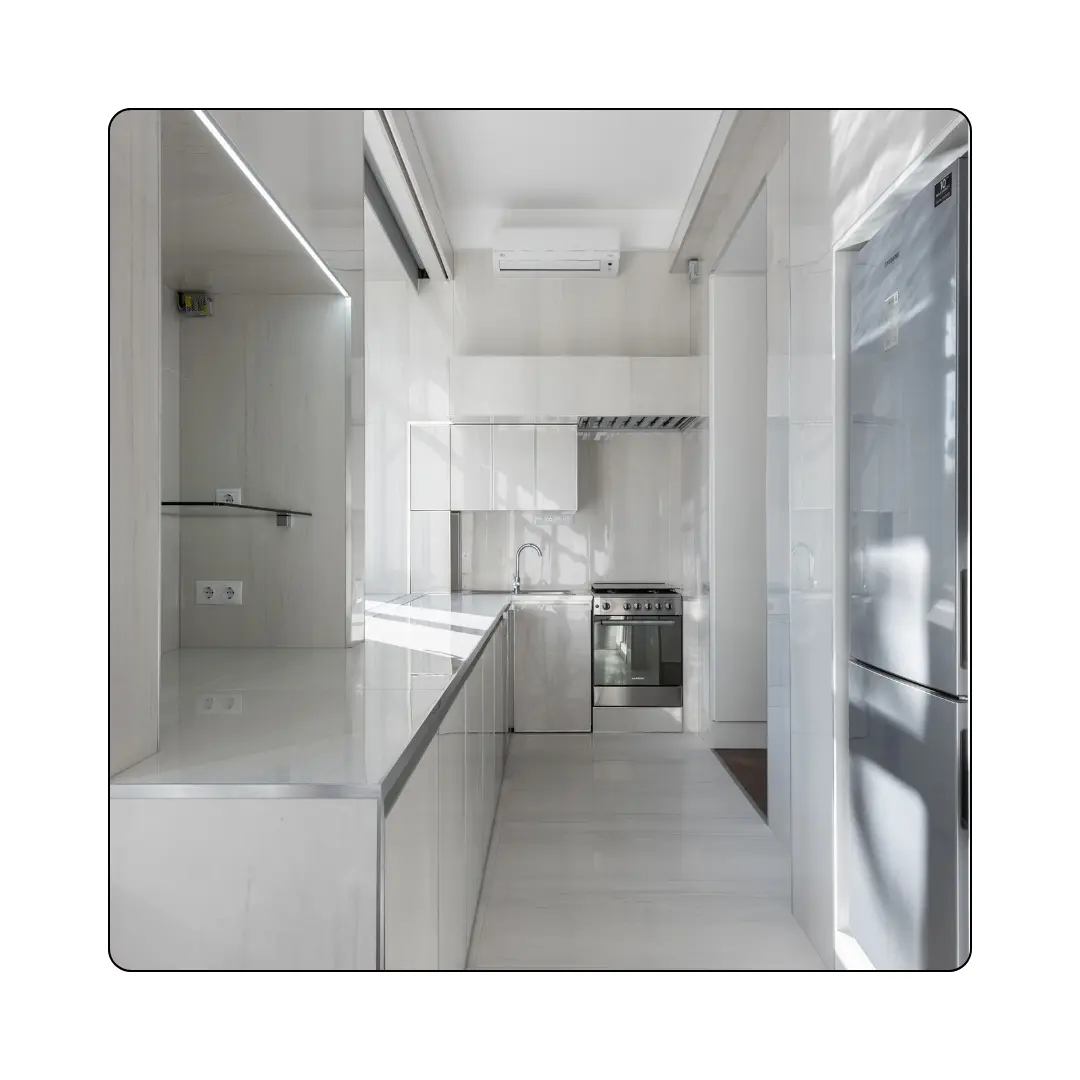

Table of Contents
ToggleIntroduction
- In today’s world, urban living often comes with compact spaces, and finding ways to make these areas functional, stylish, and comfortable is key. The kitchen, often referred to as the heart of the home, deserves particular attention to ensure it is both efficient and inviting, even in limited spaces.
- One layout that works exceptionally well in compact areas is the parallel kitchen, also known as the galley kitchen. With two counters running parallel to each other, this design is especially suited for narrow, smaller spaces. This blog will explore why the parallel kitchen layout is ideal for compact areas, detailing its advantages and offering design tips to make the most of every inch.
Why a Parallel Kitchen is Ideal for Compact Spaces?

- A parallel kitchen layout makes excellent use of narrow or smaller spaces by aligning two counters on opposite walls, creating a corridor-like design that’s perfect for tight areas. Let’s delve into why this layout shines in compact settings:
1. Optimized Use of Space
- Parallel kitchens maximize efficiency by using both walls for storage and workspace. This makes it easy to access essentials without feeling cramped.
- By having two counters, you can allocate one for meal prep and cooking, while the other can house cleaning or storage options.
2. Ideal Work Triangle for Cooking
- The “kitchen triangle” concept is crucial for an effective workspace, meaning the distance between the sink, stove, and refrigerator is minimized for easy flow.
- In a parallel kitchen, these work zones are located on opposite counters, making it easy to move between them without overcrowding.
3. Space for Multiple Users
- In smaller kitchens, accommodating more than one person can be a challenge. With the parallel layout, two people can work simultaneously, as they have distinct zones on opposite sides.
- This setup fosters better collaboration and reduces the likelihood of congestion, which is a common problem in more compact layouts.
4. Improved Storage Options
- Compact kitchens often struggle with storage, but parallel designs allow for maximum cabinetry, as both walls can support overhead and base cabinets.
- Clever storage solutions such as pull-out shelves, lazy Susans, and drawer dividers can be integrated easily to make full use of each cabinet.
5. Enhanced Aesthetics and Lighting
- Even in compact areas, you can add stylish finishes to a parallel kitchen. Bright, reflective surfaces, such as gloss-finish cabinets and tiles, can make the kitchen feel larger.
- Adequate lighting, both under-cabinet and ceiling lights, can further enhance the open feel, making the kitchen appear airy and welcoming.
6. Effortless Maintenance and Cleaning
- Smaller spaces often benefit from easy maintenance. The narrow setup of a parallel kitchen means fewer surfaces to clean.
- With no hard-to-reach corners or overly wide counters, cleaning becomes quick and manageable—ideal for busy individuals or families.
Advantages of a Parallel Kitchen in Compact Areas

Here are some of the core advantages of choosing a parallel kitchen for compact spaces:
1. Optimized Workflow
The layout creates a linear flow that’s convenient and efficient for moving between tasks, which is especially useful when space is limited.
2. Maximum Storage Capacity
With two rows of cabinets, there’s ample room for storing cookware, food, and other kitchen essentials.
3. Better Space Management
By utilizing two opposing walls, the layout provides more space in the center for easy movement.
4. Easy Access to Appliances
In smaller kitchens, proximity to appliances is important. A parallel kitchen allows for efficient placement and access to stoves, sinks, and refrigerators.
5. Cost-Effective Design
Since fewer materials are typically required for a narrower kitchen, the parallel layout is generally more budget-friendly than other designs.
Design Tips for a Parallel Kitchen in Compact Areas

To make the most of a parallel kitchen in a compact area, consider these design tips:
1. Use Light Colors
Light colors create a sense of spaciousness, so consider whites, pastels, or light wood finishes for cabinets and walls.
2. Maximize Vertical Storage
Vertical storage solutions like tall cabinets or open shelves make use of height, which is often underutilized in compact kitchens.
3. Install Good Lighting
Good lighting is essential to make a smaller kitchen feel larger. Use a mix of task lighting, ambient lighting, and under-cabinet lighting to keep the area well-lit.
4. Integrate Slim and Smart Appliances
Choose compact or built-in appliances that take up less space but don’t compromise functionality. Slim refrigerators, under-counter ovens, and smaller sinks can make a big difference.
5. Consider Sliding or Pocket Doors
If your kitchen has an entry door, opting for a sliding or pocket door can save floor space and improve the kitchen’s accessibility.
6. Add Reflective Surfaces
Reflective surfaces, such as glass or metallic backsplashes, can make the kitchen appear brighter and more spacious.
7. Utilize Corner Space Efficiently
Use rotating shelves or pull-out storage in corners to avoid wasted space, especially where the cabinets meet the walls.
8. Incorporate Multifunctional Furniture
If you have a slightly wider parallel kitchen, consider adding a foldable or pull-out table for additional counter space that can be used as a breakfast bar or prep area.
Making the Most of a Parallel Kitchen for Compact Spaces

A parallel kitchen is not just functional; with thoughtful design, it can also be a stylish and inviting space in a compact area. Here are some ways to make your parallel kitchen truly shine:
1. Blend Open and Closed Storage
A mix of open shelves and closed cabinets creates visual interest without overcrowding the space. Display attractive items on open shelves while keeping essentials tucked away.
2. Choose Functional Flooring
Flooring in a compact kitchen can impact the feel of the space. Lighter shades of tile or vinyl, which are easy to clean and slip-resistant, are ideal for a compact parallel kitchen.
3. Use the Space for Entertaining
In open-plan homes, a parallel kitchen can double as an entertainment area. Position one counter as a serving or bar area, making it a versatile spot for guests to gather while you cook.
4. Incorporate Smart Technology
Compact kitchens benefit greatly from smart appliances. Consider voice-controlled lights, smart ovens, or compact multi-cookers to add convenience and save space.
5. Add a Touch of Greenery
A small plant or herb garden on an open shelf or windowsill can bring a fresh, natural touch to a compact parallel kitchen, adding beauty and functionality without taking up counter space.
Conclusion
- A parallel kitchen is an ideal choice for those working with compact spaces. It’s a layout that optimizes space, promotes efficient workflow, and maximizes storage. With the right design approach, this layout can make a small kitchen feel open, organized, and welcoming.
- By implementing clever storage solutions, opting for light colors, and incorporating good lighting, a parallel kitchen can transform a compact area into a functional and stylish hub of the home. Whether designing a new kitchen or remodeling an existing one, the parallel layout is a smart, cost-effective choice that combines style with practicality.
Have questions about your next renovation project? We’ve got answers. Let’s do this together.
Follow House Beautiful on Instagram.
FAQ
A parallel kitchen, often referred to as a galley kitchen, features two countertops running parallel to each other, typically with a walkway in between. This layout contrasts with other kitchen designs, such as U-shaped or L-shaped kitchens, which have varying configurations involving three or two walls, respectively.
The primary advantage of a parallel kitchen lies in its efficient use of space, particularly in narrow areas. Unlike U-shaped kitchens that may take up more width and require a larger footprint, parallel kitchens can fit comfortably in tighter spaces while still offering ample storage and workspace. The linear design promotes an efficient workflow, making it easier to move between key areas—the sink, stove, and refrigerator—without unnecessary distance.
Choosing a parallel kitchen layout for compact spaces comes with several significant benefits:
Optimized Space Usage: By utilizing both walls for storage and workspace, parallel kitchens maximize the available area. This design allows for efficient organization of kitchen essentials while minimizing clutter.
Efficient Workflow: The “kitchen triangle” concept, which involves keeping the sink, stove, and refrigerator in close proximity, is easy to achieve with a parallel layout. This configuration allows for seamless movement between these key areas, enhancing overall cooking efficiency.
Accommodates Multiple Users: Parallel kitchens provide distinct zones on either side, enabling more than one person to work simultaneously without crowding. This feature is particularly useful for families or individuals who often cook together.
Enhanced Storage Solutions: With the capability to install cabinetry on both walls, parallel kitchens can offer maximum storage options. From overhead cabinets to base cabinets, there is plenty of room for organizing pots, pans, and pantry items.
Cost-Effective Design: The simplicity of the design typically requires fewer materials, making it a budget-friendly option compared to more complex layouts.
Making a parallel kitchen feel larger and more inviting can be achieved through thoughtful design choices:
Light Colors: Opting for light hues, such as whites, pastels, or light wood finishes, can help create an illusion of more space. Lighter colors reflect more light, enhancing the overall brightness of the kitchen.
Good Lighting: Incorporating a mix of lighting solutions—task lighting for work areas, ambient lighting for overall brightness, and under-cabinet lighting for additional illumination—can significantly improve the kitchen’s atmosphere. Well-lit spaces feel more open and welcoming.
Reflective Surfaces: Adding reflective materials like glass or metallic backsplashes can create a sense of depth and brightness, further amplifying the feeling of space.
Open and Closed Storage: Combining open shelves and closed cabinets adds visual interest while avoiding a cluttered appearance. Display attractive dishware or décor on shelves, while keeping essential items hidden away.
To maximize the functionality and aesthetics of a parallel kitchen, consider these design tips:
Maximize Vertical Storage: Utilize tall cabinets or open shelving to take advantage of vertical space. This approach is particularly effective in compact kitchens where horizontal space is limited.
Smart Appliances: Incorporate slim, built-in appliances that provide essential functions without occupying too much space. Compact refrigerators, under-counter ovens, and smaller sinks can help maintain an organized look.
Utilize Corner Spaces: Avoid wasted space by integrating rotating shelves or pull-out storage solutions in corners. These clever designs ensure that even the hard-to-reach areas are functional.
Consider Sliding or Pocket Doors: If your kitchen has an entry door, opting for sliding or pocket doors can free up valuable floor space, enhancing accessibility.
Maintaining a parallel kitchen for easy cleaning involves thoughtful design and practical choices:
Fewer Surfaces: The narrow setup of a parallel kitchen generally means fewer surfaces to clean. Opt for smooth, easy-to-wipe surfaces that minimize grime build-up.
Seamless Materials: Consider using continuous surfaces, such as solid countertops without seams, to reduce crevices where dirt can accumulate.
Regular Organization: Regularly decluttering and organizing cabinets will prevent buildup of items that can make cleaning challenging. Use drawer dividers and storage bins for better organization.
Efficient Layout: The linear design allows for easy access to all areas, so you can quickly clean without having to navigate around obstacles.
Absolutely! A parallel kitchen can seamlessly integrate into an open-plan living area. Here are some ways to make it work:
Designate Zones: Clearly define the kitchen area within the open space using a mix of flooring or an island. This helps maintain the kitchen’s functionality while allowing it to coexist with living or dining areas.
Create a Social Space: Position one of the counters as a serving area or breakfast bar to encourage social interaction. This setup can transform the kitchen into a gathering space while cooking.
Use Consistent Aesthetics: Ensure that the kitchen’s design elements—such as colors, materials, and finishes—harmonize with the overall style of the open-plan space. This cohesion enhances the aesthetic flow throughout the area.
Incorporate Smart Technology: Smart appliances can add functionality while minimizing clutter, making it easier to integrate the kitchen into a larger living space.




